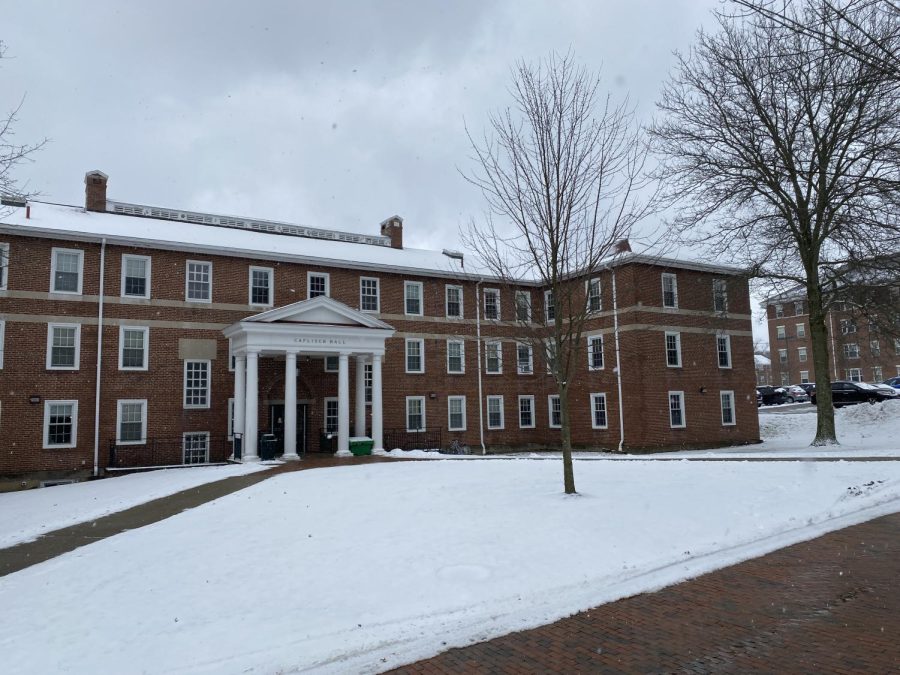Two dorms offline next academic year
Caflisch Hall, erected in 1929 is one of the oldest and most energy consumptive dorms on campus. It, along with Allegheny Hall, will not be open for residents during the 2023-24 academic year.
Two residence halls will not be housing students during the 2023-24 academic year.
An email sent to the student body from the Student Life Team provided updates for the beginning of the spring 2023 semester, including instructions for upcoming student housing selection for fall 2023.
“So that you can plan ahead, please be aware that we will not be housing students in Caflisch Hall next year,” the email stated.
Moreover, Allegheny Hall, which has been used as quarantine housing throughout the 2022-23 academic year, will also not be housing students next semester, according to the Director of Physical Plant Joseph Michael.
The Student Life and Residence Life team collaboratively decided on this decision, according to Dean for Student Life Trae Yeckley.
“The reason Caflisch will be offline is that we have quite a few open beds in the building at this moment,” Yeckley said. “We are looking to make the best use of our space and our resources.”
Allegheny College’s enrollment has been steadily dropping over the last 10 years, according to Allegheny College Institutional Research. In fall 2012, the college’s enrollment was 2,140, dropping to 1,802 in fall 2018 and reaching its lowest at 1,413, presently, in spring 2023. During this time period, the enrollment numbers peaked at 2,161 during fall of 2013.
“We can’t specify enrollment data to correlate with our decision to close Caflisch, but it is understood that we have had higher enrollment numbers in the past,” Yeckley said.
Michael said that Caflisch is particularly high in power consumption, as it is one of the oldest active buildings on campus.
The building was first erected in 1929 partially due to a donation from Margaret Caflisch as a memorial to her husband Jacob Caflisch, according to Allegheny College’s Class of 1966 55th reunion website. Later, during World War II, Caflisch Hall was used as military barracks.
Michael added that Caflisch is being decommissioned due to vacancies not just in the hall itself, but also in other residential buildings across campus.
“Various buildings have open floors and an excess of beds,” Michael said. “However, considering utilities and other costs, it made sense to take just one building offline. This has happened before; for example, Allegheny Hall was taken off a couple of years ago.”
Michael elaborated that the college’s infrastructural needs are part of the Allegheny College Master Plan — an agenda for the college’s future that is rewritten every 10 years.
“The last Master Plan was made in 2019 and it included an objective to more efficiently and effectively utilize our resources, particularly when it comes to residential and student power consumption,” Michael said. “The plan was originally to sell most of the college-owned houses as they are frequently unoccupied and consume significant amounts of energy.”
Although rewritten every 10 years, the Master Plan is evaluated annually to cater to the real-time needs of the college.
“We decided to make a residential building offline as it allows us to become more efficient with our space and energy consumption,” Michael said. “Also, we want students to have more variety with housing so we wanted to keep the college-owned houses and take away a building that is not as popular as a housing destination for students.”
The Master Plan contains a “residence halls” section which includes plans to renovate restrooms in several residential buildings, including Balwdin and Schultz Hall, decommission 11 off-campus houses and renovate 10 off-campus houses.
Although it is still unclear as to what purpose Caflisch will serve in the future, Michael and Yeckley both believe that renovation could be a part of the plan.
“We decided to have a conversation about the building towards the end of last semester and solidified the decision to make it unavailable just as this semester began,” Yeckley said.
“(Physical Plant and Student and Residence Life) will be meeting together over the course of this semester to discuss what we plan to do with the building,” Michael said.
Michael added that it is a possibility that the funds saved from power consumption and maintenance from closing the building could be used in any potential renovations the college may plan in future.
Having Caflisch decommissioned for one academic year will entail savings up to $100,000, according to Michael.
For now, the pipes in Caflisch and Allegheny Halls will be maintained with ample heat so that they do not freeze during colder months, said Michael.
“Because the buildings are aged, it is very important for us to ensure that the pipes do not burst or that the vents do not get jammed,” Michael said.
Resident Advisor Trey Williams, ’24, wondered what this means for RAs currently positioned in Caflisch.
“I’m just hoping that they won’t cut the Residence Life staff and that (Caflisch RAs) will get to keep working next semester,” Williams said.
Yeckley clarified that RAs working in Caflisch this semester will not be laid off, but instead be given the option to serve as RAs in other residential buildings.
“Just like students will not have the option to stay in Caflisch next semester, RAs will not have the option either but will be encouraged to serve in other residential buildings,” Yeckley said.
Presently, it is unconfirmed how long Caflisch will be decommissioned, but is likely to return in the future as a housing option for students.
The future of Allegheny Hall, however, is more unclear.
“The problem with Allegheny Hall is that it is on a different power grid than the college and so is more difficult to manage,” Michael said. “Allegheny Hall’s power potential is lower than other buildings … for example, only one microwave can be supported at a time in the building. Otherwise the fuse trips, which is what it’s supposed to do.”
Since Allegheny Hall is unable to fully support students’ residential needs, it is unlikely that it will be available for housing until these needs are met.
“We can only focus on some projects at a time, but working on Allegheny Hall is definitely in our agenda for the future,” Michael said. “Some things may be next on the agenda, but other, more urgent things pop up that need to be addressed first.”

Hassan Javed is a junior from Lahore, Pakistan. He is majoring in Communication and Media Studies while minoring in Psychology. This is his third year...

Sydney Emerson is a member of the class of 2023. She is from Bradford, Pennsylvania and is an English major with a history minor.









Rob '90 • Jan 27, 2023 at 8:53 pm
The enrollment number cited in this story for Spring 2023 is most likely incorrect. The number quoted was for Spring 2022, not Spring 2023. AC has failed to publish its enrollment for the current academic year, which leads me to believe that the numbers are substantially lower than the 21-22 enrollment numbers published on the 10 Year Detailed Enrollment History page of AC’s Institutional Research section of its website. Substantially lower numbers would explain AC’s failure to publish its current enrollment and the recent decision to mothball a large residence hall.
Al Coppolo • Feb 4, 2023 at 7:51 am
In a Campus article last Fall (2022) Ellen Johnson estimated 2022/2023 enrollment at 1,350 students. At its peak, Allegheny had dorm capacity for 2,100 students. Taking two dorms offline makes obvious sense in light of the declining student population. Hopefully the new “free tuition” program for Pennsylvania students with family income below $50,000, will stave off further enrollment declines. Unfortunately, it does not solve the college’s declining revenue problem.
Al Coppolo ‘78